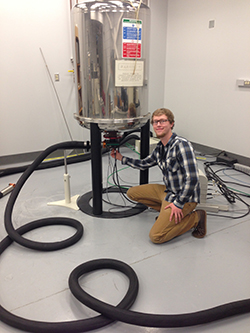Due to unsafe road conditions for Anchorage and surrounding areas, UAA’s Anchorage campus will be on a delayed start today, Thursday, Dec. 4. Campus will open at 10 a.m. to allow for safer travel.
Research
Several of the faculty members of the UAA chemistry department actively engage in research. As a result, there are plenty of opportunity for undergraduate students to pursue research interests of their own under the expert tutelage of faculty. Chemistry students have access to a full line of analytical instruments through both the chemistry department and the ASET lab.
"Computational Modeling of Aromatic-Ring Flips Dynamics"
Student Researchers: Janelle Sharp & Toni Villafranca
Faculty Advisor: Liliya Vugmeyster
Project Title: "Computational Modeling of Aromatic-Ring Flips Dynamics"
Project Description: This project focuss on the discovery of the mechanisms behind phenylalanine dynamics in the chicken villin headpiece subdomain HP36. Chicken villin is a model organism that has a simple structure and small size that correctly mimics protein folding of larger proteins. Nuclear magnetic resonance spectroscopy (NMR) on deuterium nuclei was used to collect data on phenylalanine residues of three aromatic rings in HP36's hydrophobic core. These data will be computationally compared to different motional models, varying the rates and angles that dictate the motion of these aromatic rings. The main goal of the proposed work is to analyze NMR data and test various models for motions of phenylalanine inside HP36.
"The Role of Anti-Freeze Peptide from Antarctic Yeast Organisms on Liquid Water Content of Antarctic Soils"
 Student Researcher: Matthew Clark
Student Researcher: Matthew Clark
Faculty Advisor: Liliya Vugmeyster
Project Title: "The Role of Anti-Freeze Peptide from Antarctic Yeast Organisms on Liquid Water Content
of Antarctic Soils"
Project Description: Antarctic Dry Valley soils provide a model for the Martian climate. The study of
unfrozen water in these soils allows further understanding of the possibility of life
on Mars. The freezing point of water can be lowered due to the presence of solutes,
and interactions with the soil matrix, allowing the existence of unfrozen water during
subzero temperatures. In this study, we will observe effects on the freezing point
of water due to these factors using Nuclear Magnetic Resonance Spectroscopy, Electrochemical
Impedance Spectroscopy, potentiometry, and computational modeling. Another way to
lower the freezing point of water is to add an antifreeze peptide, which can be produced
by organisms to help them survive in extremely cold climates. Samples containing the
antifreeze peptide will be analyzed using the same techniques as the previous samples,
allowing us to easily form conclusions about the effects of its presence.









